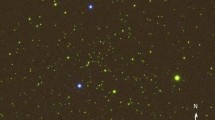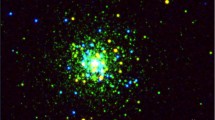Abstract
We present the study of dynamical status of the globular cluster NGC 1851. A combination of multi-wavelength space and ground-based data sets are used for the present analysis. In order to select the genuine cluster members, we used the astro-photometric data available from HST and GAIA-DR2 catalogs. The BSS radial distribution of the cluster is plotted from the center of the cluster to the outskirts. The radial distribution of BSS shows a central peak, followed by a dip at the intermediate radii (\(r_\mathrm{min}\sim 90''\)) and a rising trend in the outskirts. We also estimated \(A^{+}_{rh}\) parameter as 0.391 ± 0.006 to validate the findings of the radial distribution study. On the basis of the minima in the BSS radial distribution and the value of \(A^{+}_{rh}\) parameter, we conclude that NGC 1851 belongs to Family II classification and is an intermediate dynamical state cluster.








Similar content being viewed by others
References
Alessandrini E., Lanzoni B., Ferraro F. R., Miocchi P., Vesperini E. 2016, ApJ, 833, 252
Bailyn C. D. 1995, ARA&A, 33, 133
Baldwin A. T., Watkins L. L., van der Marel R. P., Bianchini P., Bellini A., Anderson J. 2016, ApJ, 827, 12
Beccari G., Lanzoni B., Ferraro F. R., Pulone L., Bellazzini M., Fusi Pecci F., Rood R. T., Giallongo E. 2008, ApJ, 679, 712
Beccari G., Sollima A., Ferraro F. R., Lanzoni B., Bellazzini M., De Marchi G., Valls-Gabaud D., Rood R. T. 2011, ApJ, 737, L3
Cassisi S., Salaris M., Pietrinferni A. et al. 2008, ApJL, 672, L115
Conroy C., Gunn J. E., White M. 2009, ApJ, 699, 486
Contreras Ramos R., Ferraro F. R., Dalessandro E., Lanzoni B., Rood R. T. 2012, ApJ, 748, 91
Dalessandro E., Lanzoni B., Ferraro F. R., Rood R. T., Milone A., Piotto G., Valenti E. 2008, ApJ, 677, 1069
Dalessandro E., Lanzoni B., Ferraro F. R., Vespe F., Bellazzini M., Rood R. T. 2008, ApJ, 681, 311
Ferraro F. R., Pecci F. F., Cacciari C., Corsi C., Buonanno R., Fahlman G. G., Richer H. B. 1993, AJ, 106, 2324
Ferraro F. R., D’Amico N., Possenti A., Mignani R. P., Paltrinieri B. 2001, ApJ, 561, 337
Ferraro F. R., Beccari G., Rood R. T., Bellazzini M., Sills A., Sabbi E. 2004, ApJ, 603, 12
Ferraro F. R., Lanzoni B., Raso S. et al. 2018, ApJ, 860,36
Ferraro F. R., Sollima A., Rood R. T., Origlia L., Pancino E., Bellazzini M. 2006, ApJ, 638, 433
Ferraro F. R. et al. 2012, Nature, 492, 393
Gaia Collaboration et al. 2016, A&A, 595, A1
Gaia Collaboration et al. 2018, A&A, 616, A1
Harris W. E. 1996, AJ, 112, 1487
Hidalgo S. L., Pietrinferni A., Cassisi S. et al. 2018, ApJ, 856, 125
Kunder A., Salaris M., Cassisi S. et al. 2013, AJ, 145, 25
Lanzoni B., Dalessandro E., Ferraro F. R., Mancini C., Beccari G., Rood R. T., Mapelli M., Sigurdsson S. 2007, ApJ, 663, 267
Lanzoni B. et al. 2007, ApJ, 663, 1040
Lanzoni B., Dalessandro E., Perina S., Ferraro F. R., Rood R. T., Sollima A. 2007, ApJ, 670, 1065
Lanzoni B., Ferraro F. R., Alessandrini E., Dalessandro E., Vesperini E., Raso S. 2016, ApJ, 833, L29
Meylan G., Heggie D. C. 1997, A&AR, 8, 1
Miocchi P., Lanzoni B., Ferraro F. R. et al. 2013, ApJ, 774, 151
Nardiello D., Libralato M., Piotto G. et al. 2018, MNRAS, 481, 3382
Paresce F., Meylan G., Shara M., Baxter D., Greenfield P. 1991, Nature, 352, 297
Piotto G. et al. 2015, AJ, 149, 91
Raso S., Ferraro F. R., Dalessandro E. et al. 2017, ApJ, 839, 64
Raso S., Pallanca C., Ferraro F. R. et al. 2019, ApJ, 879,56
Renzini A., Fusi Pecci F. 1988, ARA&A, 26, 199
Sabbi E., Ferraro F. R., Sills A., Rood R. T. 2004, ApJ, 617, 1296
Sahu S., Subramaniam A., Cote P., Rao N. K., Stetson P. B. 2019, MNRAS, 482, 1080
Sandage A. R. 1953, AJ, 58, 61
Sanders W. L. 1971, A&A, 14, 226
Sanna N., Dalessandro E., Ferraro F. R., Lanzoni B., Miocchi P., O’Connell R. W. 2014, ApJ, 780, 90
Shara M. M., Saffer R. A., Livio M. 1997, ApJ, 489, L59
Singh G., Sahu S., Subramaniam A., Yadav R. K. S. 2020, ApJ, 905, 44
Singh G., Yadav R. K. S. 2019, MNRAS, 482, 4874
Sirianni M., Jee M. J., Benitez N. et al. 2005, PASP, 117, 1049
Stetson P. B., Pancino E., Zocchi A., Sanna N., Monelli M. 2019, MNRAS, 485, 3042
Subramaniam A., Tandon S. N., Hutchings J. et al. 2016, Society of Photo-Optical Instrumentation Engineers (SPIE) Conference Series, vol. 9905, In-orbit Performance of UVIT on ASTROSAT, 99051F
Subramaniam A., Sahu S., Postma J. E. et al. 2017, AJ, 154, 233
Tandon S. N., Subramaniam A., Girish V. et al. 2017, AJ, 154, 128
Acknowledgements
We are thankful to the reviewer for the thoughtful comments and suggestions that improved the quality of the manuscript. This publication uses the data from the AstroSat mission of the Indian Space Research Organisation (ISRO), archived at the Indian Space Science Data Centre (ISSDC). This publication uses UVIT data processed by the payload operations centre at IIA. The UVIT is built in collaboration between IIA, IUCAA, TIFR, ISRO and CSA. This work has made use of data from the European Space Agency (ESA) mission Gaia (https://www.cosmos.esa.int/gaia), processed by the Gaia Data Processing and Analysis Consortium (DPAC, https://www.cosmos.esa.int/web/gaia/dpac/consortium). Funding for the DPAC has been provided by national institutions, in particular, the institutions participating in the Gaia Multilateral Agreement. This research has made use of data, software and/or web tools obtained from the High Energy Astrophysics Science Archive Research Center (HEASARC), a service of the Astrophysics Science Division at NASA/GSFC and of the Smithsonian Astrophysical Observatory’s High Energy Astrophysics Division.
Author information
Authors and Affiliations
Corresponding author
Additional information
This article is part of the Special Issue on “AstroSat: Five Years in Orbit”.
Rights and permissions
About this article
Cite this article
Singh, G., Yadav, R.K.S., Sahu, S. et al. Study of dynamical status of the globular cluster NGC 1851 using ultraviolet imaging telescope. J Astrophys Astron 42, 53 (2021). https://doi.org/10.1007/s12036-021-09725-3
Received:
Accepted:
Published:
DOI: https://doi.org/10.1007/s12036-021-09725-3




